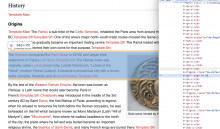Background
Changing the paragraph spacing as part of the accessibility for reading project has introduced several unintentional computed vertical spacing values in articles.
User story
As a Wikipedia reader, I want the vertical spacing between text elements in articles to follow rational information hierarchy and be consistent.
Requirements
- Add task requirements. Requirements should be user-centric, well-defined, unambiguous, implementable, testable, consistent, and comprehensive
Design
- Design spec needed
Acceptance criteria
- Evaluate options required to:
- Address T358808, T358724, T358893, T357084, T361038
- Document each recommendation made as part of the fixes and publish as a spec at the end of working on ticket
- Create wikitext mockup page with all these interactions https://en.wikipedia.beta.wmflabs.org/wiki/User:BWang/sandbox
- document outcome and propose next steps Fix this in https://phabricator.wikimedia.org/T362939
Communication criteria - does this need an announcement or discussion?
- Add communication criteria



